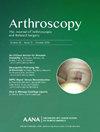Medial Meniscus Root Tears: Anatomy, Repair Options, and Outcomes
IF 4.4
1区 医学
Q1 ORTHOPEDICS
Arthroscopy-The Journal of Arthroscopic and Related Surgery
Pub Date : 2025-03-17
DOI:10.1016/j.arthro.2025.01.005
引用次数: 0
Abstract
Meniscal root tears are defined as complete avulsions of the meniscus at the site of tibial attachment or meniscal tears within 1 cm of the meniscotibial attachment sites. This injury often is seen in individuals older than the age of 50 years who have a sedentary lifestyle and can lead to the progression of osteoarthritis if not treated properly; in contrast, a traumatic etiology may be observed in younger individuals. Recent literature has defined the association between medial meniscal root tears and meniscal extrusion, defined by >2 mm of overhang of the medial meniscus over the medial border of the tibial plateau. Surgical repair often is indicated for unstable meniscal root tears, as these injuries are functionally equivalent to a total meniscectomy because of a complete loss of circumferential fibers and hoop stresses. There are 2 main repair techniques: transtibial pullout and suture anchor repairs. Repair using the transtibial pullout technique involves drilling a tunnel from the anterior proximal tibia to the anatomic insertion site of the meniscal root. Sutures are then passed through the medial root, retrieved through the tunnel, and secured with a cortical button or suture anchor on the anterior tibial cortex. Suture anchor repairs either involve passing sutures through the meniscal root and into a suture anchor at the footprint. A supplemental centralization technique is a new advancement designed to reduce meniscal extrusion and involves fixation of the meniscal body with a suture anchor at the peripheral medial plateau. Medial meniscal root repair is associated with improved patient-reported outcomes and a reduced rate of knee replacement.
内侧半月板根部撕裂:解剖、修复选择和结果
摘要半月板根撕裂是指半月板胫骨附着部位的完全撕脱或半月板附着部位1cm内的半月板撕裂。这种损伤常见于50岁以上久坐不动的生活方式,如果治疗不当,可能导致骨关节炎的进展;相反,创伤性病因可在年轻个体中观察到。最近的文献已经定义了内侧半月板根撕裂和半月板挤压之间的关系,定义为内侧半月板在胫骨平台内侧边界上方伸出2毫米。手术修复通常适用于不稳定的半月板根撕裂,因为这些损伤在功能上相当于半月板全切除术,因为周围纤维和环应力完全丧失。有两种主要的修复技术:经胫骨拔出和缝合锚修复。使用经胫骨拉出技术进行修复,包括从胫骨前近端到半月板根的解剖插入点钻一个隧道。然后将缝线穿过内侧根,通过隧道取出,并用皮质扣或缝合锚固定在胫骨前皮质上。缝合锚定修复包括将缝线穿过半月板根并在足部置入缝合锚定。辅助集中技术是一种新的进步,旨在减少半月板挤压,包括在周围内侧平台用缝合锚固定半月板体。内侧半月板根修复与改善患者报告的预后和降低膝关节置换率相关。
本文章由计算机程序翻译,如有差异,请以英文原文为准。
求助全文
约1分钟内获得全文
求助全文
来源期刊
CiteScore
9.30
自引率
17.00%
发文量
555
审稿时长
58 days
期刊介绍:
Nowhere is minimally invasive surgery explained better than in Arthroscopy, the leading peer-reviewed journal in the field. Every issue enables you to put into perspective the usefulness of the various emerging arthroscopic techniques. The advantages and disadvantages of these methods -- along with their applications in various situations -- are discussed in relation to their efficiency, efficacy and cost benefit. As a special incentive, paid subscribers also receive access to the journal expanded website.

 求助内容:
求助内容: 应助结果提醒方式:
应助结果提醒方式:


